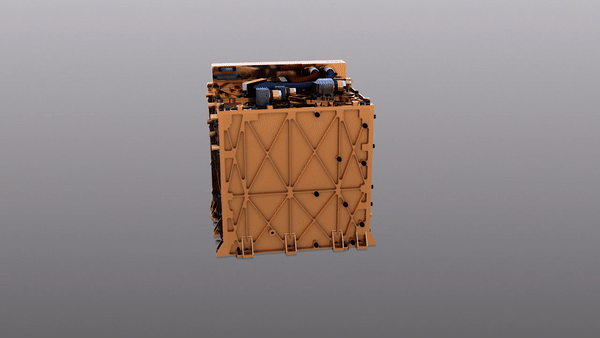A Lunchbox-Sized Device Is Making Oxygen on Mars
By scaling up the technology, NASA could allow future astronauts to breathe on the Red Planet
:focal(3660x2440:3661x2441)/https://tf-cmsv2-smithsonianmag-media.s3.amazonaws.com/filer_public/4b/ee/4bee7357-608f-4aae-9408-8d9aabf87d2f/nasa_moxie.jpeg)
If humans are ever going to travel to Mars, they’ll need to get oxygen from somewhere. Compared to the Earth’s atmosphere, which is 21 percent oxygen, the Red Planet’s atmosphere is a miniscule 0.16 percent oxygen.
Now, thanks to a lunchbox-sized instrument aboard NASA’s Perseverance Rover, there might be a chance to make more of the breathable gas on Mars. The device successfully produced oxygen from the Martian atmosphere in seven different tests conducted in 2021, according to a paper published last week in the journal Science Advances.
If astronauts were to travel to Mars, they’d need oxygen to breathe. But they’d also need the gas to fuel rockets to get back to Earth, reports Vice’s Sarah Wells. Michael Hecht, principal investigator of the project and a research scientist at MIT, told Vice in an email that “just for the lift-off to orbit,” a rocket would need ten times the oxygen that four to six astronauts would use in 18 months on Mars.
In theory, NASA could send oxygen from Earth to the Red Planet, but it would require multiple expensive rocket launches, Jeffrey Hoffman, deputy principal investigator of the project, tells the Washington Post’s Pranshu Verma. But using this instrument to create the oxygen on site would be cheaper, says Hoffman, an aerospace engineer at MIT and former NASA astronaut.
The instrument, called MOXIE, or the Mars Oxygen In-Situ Resource Utilization Experiment, was able to produce six grams of oxygen per hour during the tests—about the rate of a small tree, according to a press release.
MOXIE makes oxygen by compressing and heating carbon dioxide from Mars’s atmosphere to almost 1,500 degrees Fahrenheit, causing it to split into oxygen ions and carbon monoxide, per Vice. Then, the device recombines the oxygen ions to make breathable and combustible oxygen gas. Hecht tells Vice that the process's byproducts are not harmful to the Martian atmosphere.
With these experiments, MOXIE has proven it can work reliably, Hecht tells Insider’s Paola Rosa-Aquino. Across tests run in a variety of conditions, the small device produced a total of 100 minutes’ worth of breathable oxygen for one astronaut. It performed predictably during day and night, in different extreme temperatures and following a dust storm, per New Scientist’s Jacklin Kwan. “The only thing we have not demonstrated is running at dawn or dusk, when the temperature is changing substantially,” Hecht says in the press release.

But in order to make enough oxygen to support a mission to Mars and send people back to Earth, Hoffman tells the Post that a device like MOXIE would need to create at least 4.5 to 6.5 pounds of oxygen per hour, which “would require scaling things up by several hundred times,” he says. The researchers are now working on making a larger device that’s about a cubic meter in size, according to New Scientist.
To support a human mission, a bigger device would need to be running continuously for 400 days, says Gerald Sanders of the NASA Johnson Space Center in Texas, who is not one of the new paper’s authors, to New Scientist. “That’s a lot of hours to put on the hardware, irrespective of what the technology is,” he says to the publication.
Hecht tells Insider that scaling up the technology shouldn’t be too difficult. But Sanders points out to New Scientist that there may be some challenges, such as managing a larger device’s internal temperature.
NASA is now testing the hardware needed for this larger version of MOXIE, per New Scientist. The future MOXIE “is the one that really counts,” Hecht tells Insider.
The project, researchers say, will lay the groundwork for future space travel. “It’s what explorers have done since time immemorial,” Hoffman tells the Post. “Find out what resources are available where you’re going to and find out how to use them.”
/https://tf-cmsv2-smithsonianmag-media.s3.amazonaws.com/accounts/headshot/Will-Sullivan-photo.png)
/https://tf-cmsv2-smithsonianmag-media.s3.amazonaws.com/accounts/headshot/Will-Sullivan-photo.png)